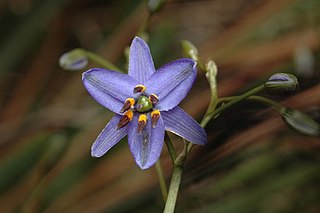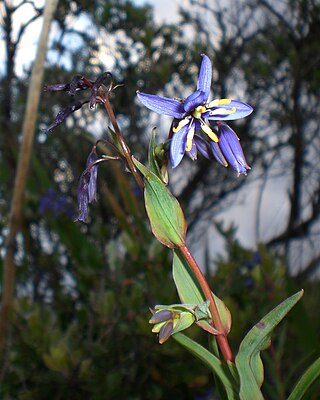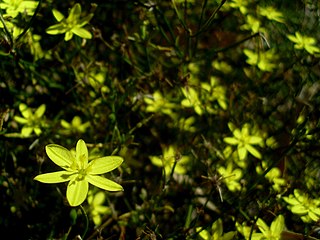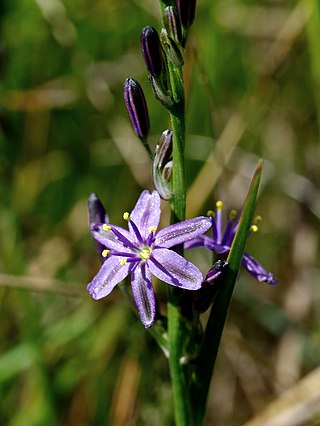
Asphodelaceae is a family of flowering plants in the order Asparagales. Such a family has been recognized by most taxonomists, but the circumscription has varied widely. In its current circumscription in the APG IV system, it includes about 40 genera and 900 known species. The type genus is Asphodelus.

Dianella is a genus of about forty species of flowering plants in the monocot family Asphodelaceae, commonly known as flax lilies. Plants in this genus are tufted herbs with more or less linear leaves and bisexual flowers with three sepals more or less similar to three petals and a superior ovary, the fruit a berry. They occur in Africa, South-east Asia, the Pacific Islands, New Zealand and Australia.

Dianella tasmanica, commonly known as the Tasman flax-lily or Tasmanian flax-lily is a herbaceous strappy perennial herb of the family Asphodelaceae, subfamily Hemerocallidoideae, found in southeastern Australia including Tasmania. It has leaves to 80 cm, and a flower stem to 1.5 m. Blue flowers in spring and summer are followed by violet berries. It adapts readily to cultivation and is commonly seen in Australian gardens. Unlike other Dianella species, its fruit is toxic.

Dianella caerulea, commonly known as the blue flax-lily, blueberry lily, or paroo lily, is a perennial herb of the family Asphodelaceae, subfamily Hemerocallidoideae, found across the eastern states of Australia and Tasmania. It is a hardy plant, growing to a height and width of around 1 meter with grass-like strappy leaves. Blue flowers in spring and summer are followed by indigo-coloured berries. It adapts readily to cultivation and is commonly seen in Australian gardens and amenities plantings.

Stypandra is a small genus of rhizomatous perennials in the family Asphodelaceae, subfamily Hemerocallidoideae. They are native to Australia and New Caledonia.

Tricoryne is a genus of perennial herbs in the family Asphodelaceae, subfamily Hemerocallidoideae. All species are native to Australia with two species extending to New Guinea; within Australia they occur in all 6 states and the Northern Territory.
- Tricoryne ancepsR.Br. - New Guinea, Queensland
- Tricoryne corynothecoidesKeighery - Western Australia
- Tricoryne elatiorR.Br. - Yellow Rush-lily - all 6 states plus Northern Territory
- Tricoryne humilisEndl. - Western Australia
- Tricoryne muricataBaker - Queensland
- Tricoryne platypteraRchb.f - New Guinea, Queensland
- Tricoryne simplexR.Br. - New South Wales
- Tricoryne tenellaR.Br. - Mallee Rush-lily - Western Australia, South Australia

Caesia is a genus of herbs in the family Asphodelaceae, subfamily Hemerocallidoideae, native to Australia, New Guinea, Madagascar and Southern Africa. The mostly 3-lobed seed capsules contain rounded black seeds. The genus was named in honour of Federico Cesi (1585-1630), an Italian scientist.

Simethis is a genus of plants in the family Asphodelaceae, subfamily Hemerocallidoideae. It contains only one known species, Simethis mattiazzii, commonly called the Kerry lily.

Thelionema is a small genus of tufted perennials in the family Asphodelaceae, subfamily Hemerocallidoideae. All three species, which were previously placed in the genus Stypandra, are native to Australia. These are:

Dianella revoluta, commonly known as blueberry lily, blue flax-lily, or black-anther flax-lily, a species of flowering plant in the family Asphodelaceae and is endemic to, and widespread in Australia. It is a tufted, perennial herb with grass-like leaves and up to nine blue or violet flowers with six tepals, and stamens with bright yellow filaments and pale brown to almost black anthers.

Pelargonium sp. Striatellum, commonly known as Omeo stork's-bill, is an undescribed species of Pelargonium that is endemic to Australia. It is listed as "endangered" under the Environment Protection and Biodiversity Conservation Act, "endangered" in New South Wales and "vulnerable" in Victoria. It exists in five known locations; four in New South Wales and another in Victoria. Other populations may exist undiscovered on private land.

Caesia parviflora, the pale grass lily, is a species of flowering plant in the family Asphodelaceae, subfamily Hemerocallidoideae, native to Australia, being found in New South Wales, Queensland, Victoria, Tasmania, South Australia and Western Australia.

Dianella brevicaulis, commonly known as the coast flax-lily, is a tufted, rhizomatous, perennial herb with fibrous roots and blue-purple flowers. Its long leaves form a soft, green tussock which conceal the flowering stems. It grows to 0.5 m in height and prefers sandy soils to quite far inland. It is native to southern Australia where it is usually found in coastal and subcoastal habitats and sandy inland ranges.

Corynotheca is a genus of herbs in the family Asphodelaceae, subfamily Hemerocallidoideae, first described as a genus in 1878. The entire genus is endemic to Australia.
- Corynotheca asperataR.J.F.Hend - Western Australia, Northern Territory
- Corynotheca flexuosissimaR.J.F.Hend. - Western Australia
- Corynotheca lateriflora(R.Br.) F.Muell. ex Benth. - Northern Territory
- Corynotheca licrotaR.J.F.Hend. - Northern Territory, Queensland, New South Wales, Victoria, South Australia
- Corynotheca micrantha(Lindl.) Druce - Northern Territory, Queensland, Western Australia, South Australia
- Corynotheca pungensR.J.F.Hend. - Western Australia

Johnsonia pubescens, commonly called the pipe lily, is a grass-like plant in the family Asphodelaceae, subfamily Hemerocallidoideae, endemic to the south-west of Western Australia. As with others in the genus, it is distinguished by its minute flowers which are on the end of a spike and hidden by large, overlapping, papery bracts.
The Asparagales are an order of plants, and on this page the structure of the order is used according to the APG III system. The order takes its name from the family Asparagaceae and is placed in the monocots. The order is clearly circumscribed on the basis of DNA sequence analysis, but is difficult to define morphologically, since its members are structurally diverse. The APG III system is used in World Checklist of Selected Plant Families from the Royal Botanical Gardens at Kew. With this circumscription, the order consists of 14 families with approximately 1120 genera and 26000 species.

Dianella longifolia, commonly known as blueberry lily, pale flax lily or smooth flax lily, or blue flax-lily, is a species of flowering plant in the family Asphodelaceae and is endemic to non-arid areas of Australia. It is a tufted, rhizomatous, perennial herb with grass-like leaves, pale blue, white or greenish flowers that have pale yellow anthers, and shiny, pale blue berries.
Dianella brevipedunculata is a species of flax lily native to Eastern Australia. It is known as the blue flax lily.

Dianella ensifolia is a flowering plant, of the family Asphodelaceae. It is native to southern China, India, Japan, Madagascar, Malesia, the Pacific Islands, Singapore, Sri Lanka, Taiwan, and tropical Asia. Its common names include umbrella dracaena, common dianella, siak-siak, and flax lily.

Caesia calliantha, commonly known as the blue grass lily or blue star lily, is a species of herbaceous flowering plant. It is a member of the Asphodelaceae family, subfamily Hemerocallidoideae, native to Australia found predominantly along the East coast in Victoria, New South Wales, South Australia and Tasmania.


















